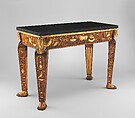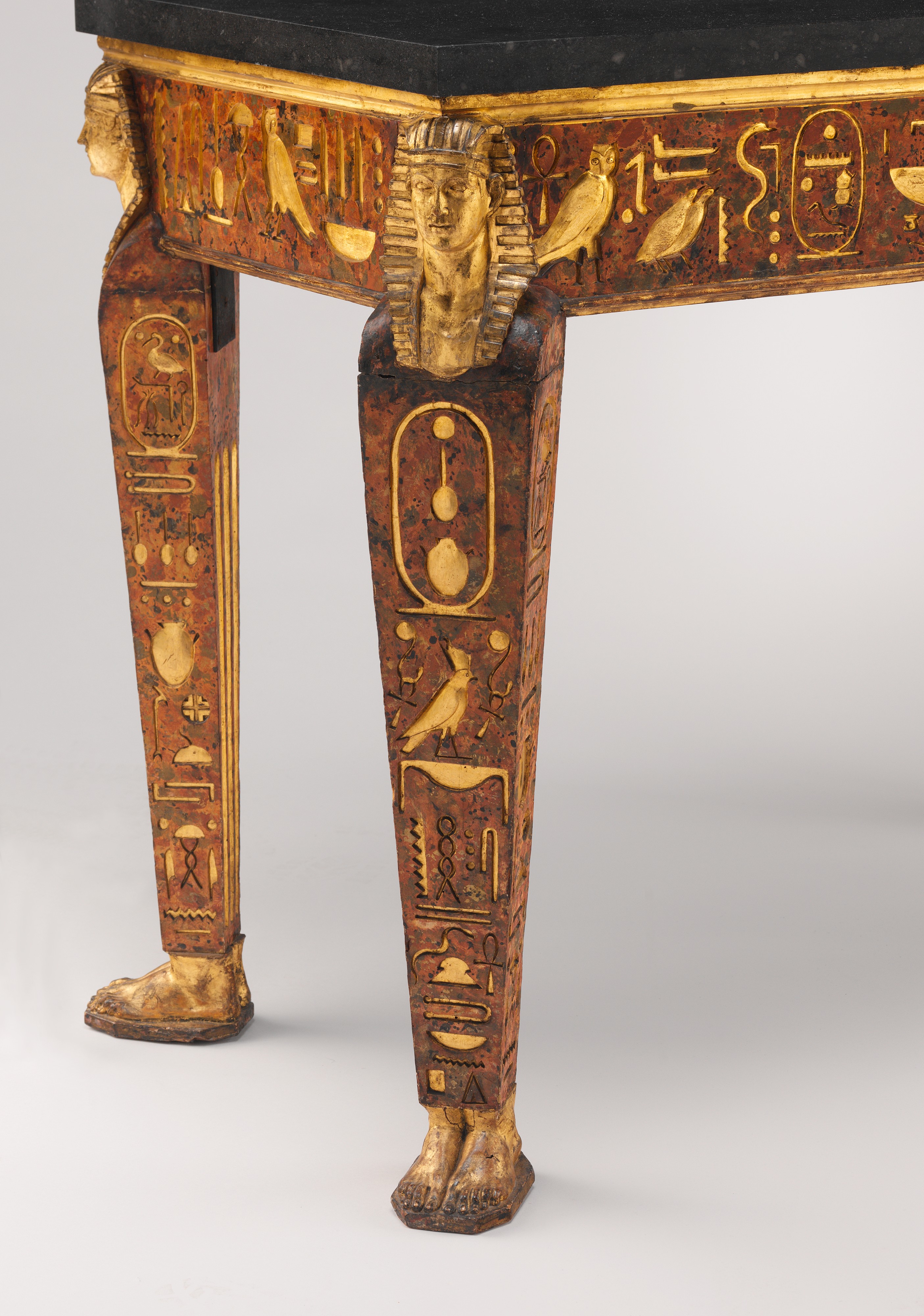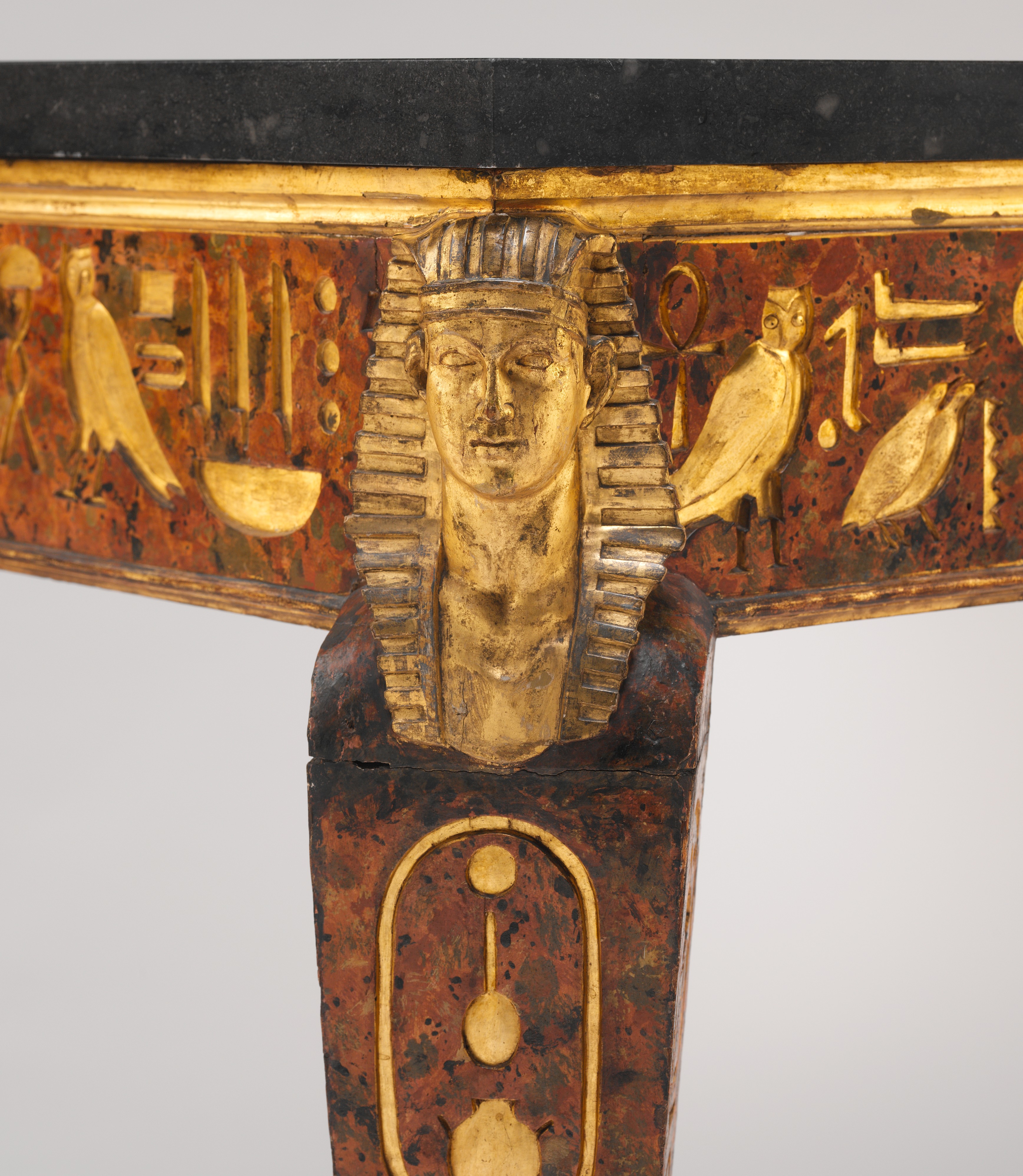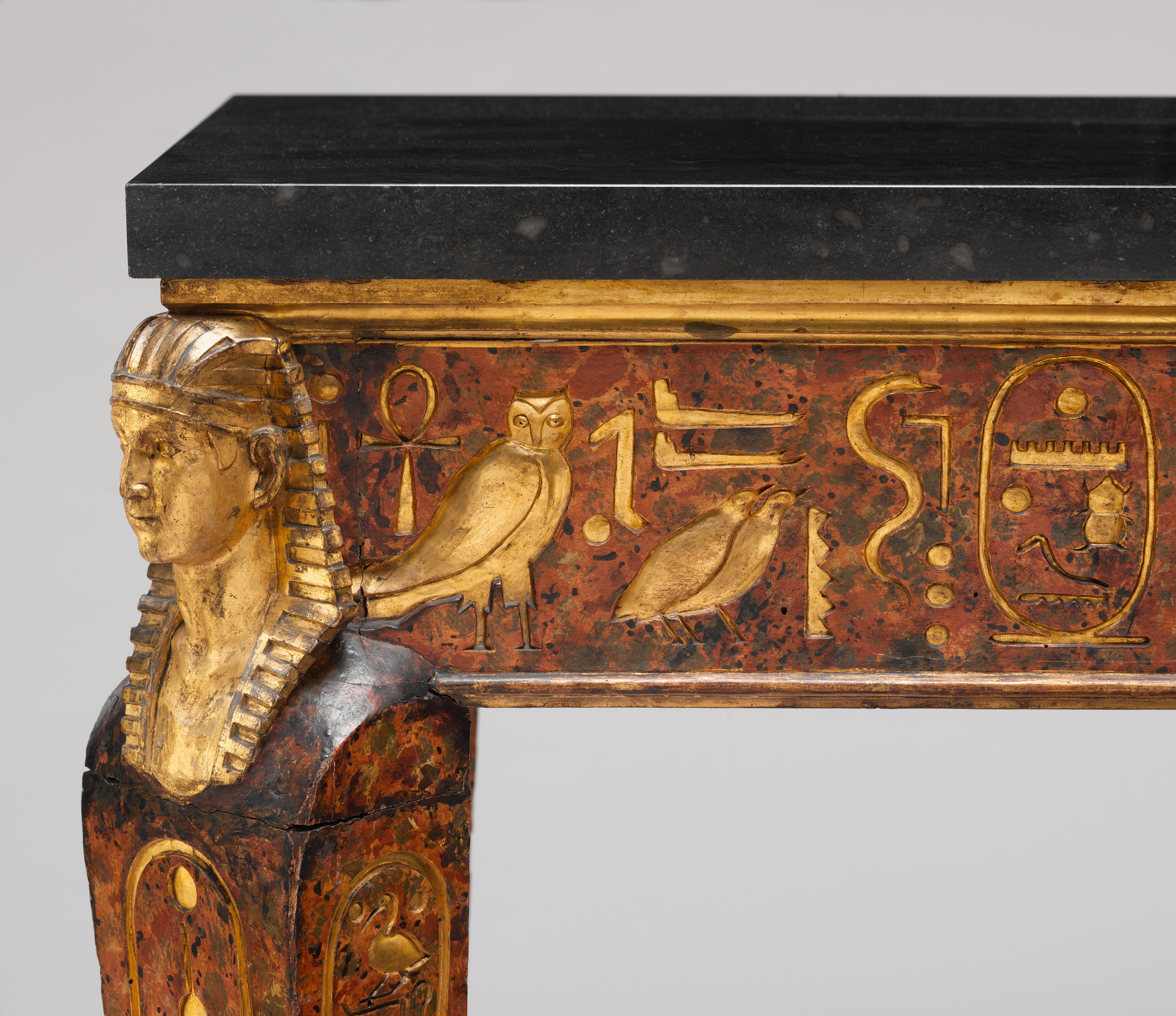Table
Arriving from Dresden in Rome in 1755, the historian of classical art Johann Joachim Winckelmann (1717–1768) stepped into a different, intensely stimulating world. The sophisticated international community settled there was experiencing a rapidly growing fascination with the ancient Mediterranean civilizations. As librarian to the collector Cardinal Alessandro Albani (1692–1779), Winckelmann spent nine productive years in the intense study of Etruscan, Greek, classical Roman, and Egyptian works. He found them "in the galleries, vaults, and gardens of Roman palaces, at Naples, and at the new excavations of Herculaneum."[1] During ancient Roman times, Egyptian monuments, such as obelisks and statues, and precious materials, such as alabaster, that formerly decorated the palaces of the pharaohs and temples on the banks of the Nile (for example, two panels on the Farnese table; see acc. no. 58.57a–d) were brought as spoils to Rome and were used to embellish public places and the imperial residences. The constant presence of Egyptian art in Italy occasionally inspired artisans of later eras to incorporate its mysterious decorative motifs into their own inventions. Sometimes it was the mere citation of a detail, such as a sphinx's paw used to support a Renaissance cassone or cabinet.[2] And because there was no understanding of pharaonic traditions and no knowledge of the land of Egypt or of its ancient writing, European artisans and scholars were unable to distinguish pharaonic originals from imperial Roman copies or interpretations. On a large scale, the frescoes by Raphael and his studio for the Sala dell'Incendio in the Vatican and the Sala Egiziana in the Palazzo Massimo alle Colonne are two of a few grand Italian interior decorations with Egyptianizing details that predate the Egyptomania that seized Europe in the wake of Napoleon's military campaign along the Nile in 1798 (see the catalogue entry for acc. no. 26.168.77).[3]
Winckelmann's patron Alessandro Albani was one of the first connoisseurs in early-eighteenth-century Rome to consider in a scholarly manner the nature and significance of Egyptian art. At his villa in Rome he built a salon decorated in the Egyptian style, which he filled with ancient Egyptian and Roman works, creating what was "probably the first such historical reconstruction in modern times."[4] A few years later, the antiquarian, architect, and engraver Giovanni Battista Piranesi (1720–1778) made designs (never executed) for chimneypieces in the Egyptian taste. These extraordinary etchings contained a wealth of Egyptian ornament arranged in an imaginative, purely decorative manner. They became "the ultimate anthology of Egyptian motifs for the remainder of the century."[5] Meanwhile, the archaeologists were continuing to unearth Egyptian works in Rome. Soon European "Neo-classical designers [were drawing] on Egypt in much the same way that Rococo designers had drawn on China."[6]
The design of this table reflects the Neo-Egyptian fashion in Rome in the late 1770s. The painted finish simulates the beautiful greenish red of Aswan granite. It is highlighted with flecks of gilding that harmonize with the gilded hieroglyphs and the sphinx heads that crown the legs, which terminate in human feet, also gilt. The hieroglyphs and cartouches, some of which are similar to those used by Piranesi in his chimney-piece designs, are identifiable, but their arrangement on the table's aprons and legs does not convey a logical message. These bold details are pulled from their context on ancient monuments and arranged in a merely decorative manner.
Who commissioned this striking piece is not known. The closest connection that can be made is with a table depicted in Laurent Pécheux's attractive 1777 portrait of Margherita Gentili Boccapaduli standing in the room devoted to her natural-history collection and other curiosities.[7] The tabletop in the portrait incorporates a mosaic of various marbles and other stones, arranged in a way that is typical of souvenirs of a grand tour. It can be assumed that the Museum's table once had a very similar top. Such highly decorative displays of stones, many of which are semiprecious, later became collector's items in their own right. This may be why the original top of the Museum's table was removed and replaced with one of black granite. There is a related table in a New York private collection, and another was recently recorded on the New York art market.[8]
This intriguing object was among the first gifts that Robert Lehman made to the Metropolitan Museum, which became one of his great interests. In 1975 he bequeathed his collection to the Museum, together with the gift of a new wing to house it.
[Wolfram Koeppe 2006]
Footnotes:
1. Lorenz Eitner. Neoclassicism and Romanticism, 1750–1850: Sources and Documents. 2 vols. Englewood Cliffs, N.J., 1970, vol. 1, p. 13. See also Johann Joachim Winckelmann. The History of Ancient Art. 4 vols. Trans. G. Henry Lodge. Boston, 1880.
2. Der Glanz der Farnese: Kunst und Sammelleidenschaft in der Renaissance. Exh. cat., Palazzo Ducale di Colorno, Parma; Haus der Kunst, Munich; and Galleria Nazionale di Capodimonte, Naples. Munich, 1995, p. 55, fig. 5.
3. A passion for the Egyptian style before Napoleon's era was not limited to Italy. Johann M. Dinglinger's Apis Altar of 1731 in the Green Vault at Dresden is a rich compendium of ancient Egyptian motifs, surmounted by an obelisk; see Dirk Syndram. Die Ägyptenrezeption unter August dem Starken: Der "Apis-Altar" Johann Melchior Dinglingers. Sonderbände der Antiken Welt. Zaberns Bildbände zur Archäologie. Mainz am Rhein, 1999, pp. 60-61. Queen Marie Antoinette adored the style (see the catalogue entry for acc. no. 41.205.1–3a,b). And, recognizing the innate appeal of Egyptian objects, David Roentgen, marketing genius sans pareil among European cabinetmakers, placed a sphinx, symbol of royal power and feminine wisdom, on either side of the writing surface of a desk that he designed in 1783 with Catherine the Great of Russia specifically in mind; see Dietrich Fabian. Abraham und David Roentgen: Das noch aufgefundene Gesamtwerk ihrer Möbel- und Uhrenkunst in Verbindung mit der Uhrmacherfamilie Kinzing in Neuwied. Leben und Werk, Verzeichnis der Werke, Quellen. Bad Neustadt, 1996, p. 100, no. 213.
4. Michael Pantazzi. "Italy and the Grand Tour." In Jean-Marcel Humbert, Michael Pantazzi, and Christine Ziegler. Egyptomania: Egypt in Western Art, 1730–1930. Exh. cat. Musée du Louvre, Paris; National Gallery of Canada, Ottawa; and Kunsthistorisches Museum, Vienna. Ottawa and Paris, 1994, p. 39.
5. Jean-Marcel Humbert, Michael Pantazzi, and Christine Ziegler. Egyptomania: Egypt in Western Art, 1730–1930. Exh. cat. Musée du Louvre, Paris; National Gallery of Canada, Ottawa; and Kunsthistorisches Museum, Vienna. Ottawa and Paris, 1994, p. 69, no. 16 (entry by Michael Pantazzi) and for Piranesi's chimneypiece designs, see pp. 69–74, nos. 16–21 (entries by Michael Pantazzi).
6. John Fleming and Hugh Honour. The Penguin Dictionary of Decorative Arts. New ed. London and New York, 1989, p. 275. For chinoiserie, see Alain Gruber. "Chinoiserie." In The History of Decorative Arts: Classicism and the Baroque in Europe, ed. Alain Gruber. Trans. John Goodman. New York, 1996.
7. Alvar González-Palacios, ed. Fasto romano: Dipinti, sculture, arredi dai palazzi di Roma. Exh. cat., Palazzo Sacchetti. Rome, 1991, pp. 141-42, no. 60, pl. XXIV (entry by Alvar González-Palacios). See also John Morley. The History of Furniture: Twenty-five Centuries of Style and Design in the Western Tradition. Boston, 1999, pp. 292-93, and fig. 603 (the present table).
8. For the first, see Jean-Marcel Humbert, Michael Pantazzi, and Christine Ziegler. Egyptomania: Egypt in Western Art, 1730–1930. Exh. cat. Musée du Louvre, Paris; National Gallery of Canada, Ottawa; and Kunsthistorisches Museum, Vienna. Ottawa and Paris, 1994, pp. 76-77, no. 23 (entry by Michael Pantazzi). The Museum's table is number 42 in that exhibition catalogue (it was shown only at the Paris venue). For the second, see catalogue of a sale at Christie's, New York, 24 September 1998, p. 149, lot 295.
Due to rights restrictions, this image cannot be enlarged, viewed at full screen, or downloaded.
This artwork is meant to be viewed from right to left. Scroll left to view more.





